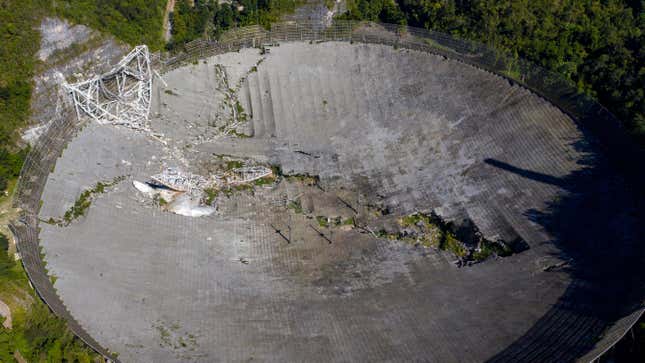
A new estimate suggests it’ll cost somewhere between $30 million and $50 million to clean up the mess created by the collapse of the iconic Arecibo Observatory dish late last year, according to an NSF report detailing the aftermath of the disaster and possible next steps.
The investigation into the cause of the collapse at the Arecibo Observatory in Puerto Rico is still ongoing, but the National Science Foundation, through the Consolidated Appropriations Act, 2021, was asked to provide a report to Congress outlining the “causes and extent of the damage, the plan to remove debris in a safe and environmentally sound way, the preservation of the associated [Arecibo Observatory] facilities and surrounding areas, and the process for determining whether to establish comparable technology at the site, along with any associated cost estimates.”
The NSF had just 60 days to produce the report upon enactment of the Act, which may explain why it’s so achingly thin on details. The report is just seven pages long and replete with information we already knew. That said, the NSF did provide some new details, such as the cleanup cost estimate, an overview of damage done to the facility, and an update on the cleanup, among other matters.
To recap, an auxiliary cable from a support tower pulled loose from its socket on August 10, 2020, resulting in extensive damage to the reflector panels below. A main cable on the same tower snapped several months later, resulting in even further damage to the dish, which has been used for radar and radio astronomy since 1963. The second cable failure was especially troubling, as “this cable broke under conditions that should have been well within its support capabilities, indicating that it, along with the remaining main cables, may have been weaker than expected,” according to the new report. Engineering firms brought in to evaluate the structure said a subsequent cable failure would be catastrophic, resulting in the decision to decommission the 1,000-foot (305-meter) dish. As plans were being made to demolish the storied radio telescope, however, the 900-ton platform gave way, collapsing on December 1, 2020.
Inspections done after the collapse showed that the platform and Gregorian dome were a “complete loss for scientific purposes,” per the report. The top 59 feet (18 meters) of platform support towers 12 and 4 broke off during the collapse, and the top 121 feet (37 meters) of platform support tower 8 snapped off. As the report states, “further assessments of the structural integrity of the towers continue.”
The roof of the Learning Center sustained significant damage, but the NSF said it’s repairable. A trailer used by Educational and Public Outreach staff was completely “demolished,” while the Visitor Center came away unscathed, save for some minor damage caused by falling bits of concrete, the new report said.
A private contractor and experts from NASA’s Kennedy Space Center are currently conducting a forensics analysis to determine the cause of the original auxiliary cable socket failure. A separate contractor is performing the forensic investigation at Arecibo, with final reports from both contractors expected in December 2021. In addition to these efforts, the NSF is asking that an “expedited independent study” into the cause of the cable failures be completed by the National Academies of Sciences, Engineering, and Medicine.
A company that specializes in disaster cleanup and environmental remediation has been brought in to help. Soils contaminated with hydraulic oils, which were released during the collapse, are being sampled and removed. The cleanup team is also testing groundwater and surface water near the facility. A “Stormwater Pollution Prevention Plan” is in the works to “prevent sediment and pollutants from migrating offsite,” as are wildlife and vegetation surveys to help in the protection of vulnerable species, according to the report.
The report lists the preliminary cost estimates for the cleanup as being between $30 million and $50 million from now until the end of 2022.
The NSF is now working with the Puerto Rico State Historic Preservation Office and the Federal Advisory Council on Historic Preservation on the “protection and preservation of historically important elements of the structures and site.” Valuable or worthwhile objects found during the cleanup process could go on display at the observatory or sent to museums.
The future of the facility remains unclear. The NSF says it’s still too soon to know how the facility might be repaired or reconstructed to enable different kinds of scientific endeavors, adding that restoration will “require differing levels of effort and funding.” The authors said “many technologies and more than a dozen distinct capabilities” are still in place at the site, including a smaller 40-foot (12-meter) radio telescope and a LIDAR facility used to study the composition and motion of the ionosphere. As for repairing or re-inventing the large dish, the NSF said its “process for establishing any significant new scientific facility relies on priorities established by the scientific community and rigorous peer review of the intellectual merit and broader impacts of the proposed activity.”
A community workshop planned for this coming April should provide more information about the Arecibo Observatory and its future.
That a radio dish could be rebuilt at the facility is not out of the question. A proposal to build a $450 million “Next Generation Arecibo Telescope” was tabled by the observatory last month. It’s been dark days at Arecibo, but perhaps there’s reason for optimism.